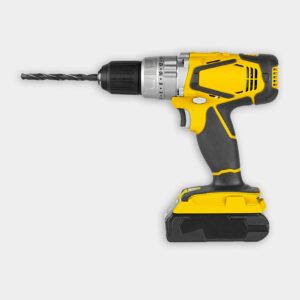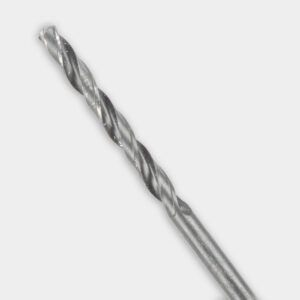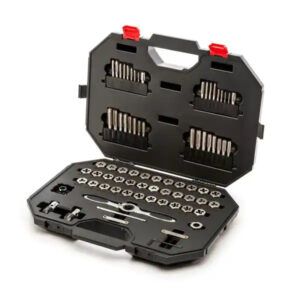Project details
Skill
Cost
Estimated Time
Radiators are essential components of many home heating systems, but if you’re not careful when working with their air vents, you can end up stripping or crossing the threads. When this happens, the new vent will no longer fit tightly into the system and is likely to leak, drastically reducing your radiator’s efficiency.
Fortunately, cast iron is fairly soft, so repairing the threads by cutting new ones is a manageable do-it-yourself (DIY) project for many homeowners. This Old House plumbing and heating contractor Richard Trethewey demonstrates the process of cutting new threads for a radiator air vent in the video above. Below, we’ll walk you through the process step by step.
Understanding Radiator Air Vents
Radiator air vents play a crucial role in the efficient operation of your heating system. These small devices allow air to escape from the radiator, ensuring that it fills completely with hot water or steam. Damaged air vent threads can lead to safety and efficiency issues.
The Importance of Proper Threading
Proper threading maintains a secure seal between the air vent and the radiator. Radiator air vent threads are typically tapered, which means they become narrower as they go deeper into the radiator. This design ensures a tight fit against pressurized steam or water, preventing leaks or failures.
Damage to Radiator Air Vent Threads
There are several ways radiator air vent threads can sustain damage.
- Cross-threading: This occurs when the air vent is inserted at the wrong angle, damaging the threads.
- Wear and tear: Over time, threads can become worn or stripped due to repeated use.
- Corrosion: In older systems, threads may become corroded, making it difficult to remove or install the air vent.
Tools and Materials Needed for Radiator Valve Threads
Before beginning the repair process, gather the following tools and materials:
- 1/8-inch to 1/4-inch bushing
- 7/16-inch high-speed steel drill bit
- Drill/driver
- New radiator air vent
- Pipe dope or thread sealant
- Ratchet wrench
- Safety glasses
- Tap and die set (specifically, a 1/4-inch NPT tap)
Step-by-Step Repair Process
Repairing radiator air vent threads requires patience and attention to detail. Follow these steps carefully for a successful repair.
1. Prepare the Radiator
Before starting the repair, ensure that the heating system is turned off and the radiator is cool. This will prevent any potential injuries from hot water or steam.
2. Enlarge the Existing Hole
Using a 7/16-inch drill bit, carefully enlarge the existing air vent hole in the radiator, creating enough space to cut new threads. As Trethewey demonstrates in the video, you must drill slowly and steadily to avoid damaging the radiator. Additionally, wear safety glasses to protect your eyes from metal shavings.
3. Cut New Threads
Once the hole is enlarged, it’s time to cut new threads.
- Insert the 1/4-inch NPT tap into a ratchet wrench.
- Carefully begin threading the tap into the enlarged hole, turning clockwise.
- Apply steady pressure and turn slowly to ensure straight, even threads.
- Periodically back out the tap to clear metal shavings, then continue threading.
4. Install the Bushing
After cutting the new threads, you’ll need to install a bushing to adapt the new 1/4-inch threads to the original 1/8-inch air vent size.
- Apply a small amount of pipe dope to the external threads of the bushing.
- Carefully thread the bushing into the newly tapped hole.
- Use a ratchet wrench to tighten the bushing securely.
5. Install the New Air Vent
With the bushing in place, you can now install the new air vent.
- Apply a small amount of pipe dope to the threads of the air vent.
- Carefully thread the air vent into the bushing by hand.
- Tighten the air vent until it’s in an upright position, but be careful not to overtighten.
Tips for Successful Radiator Air Vent Thread Repair
To ensure a successful repair and avoid common pitfalls, keep these tips in mind:
- Use the correct tap: As Trethewey says, using the wrong tap size or shape can further damage the radiator. Always use a tapered NPT tap for plumbing applications.
- Maintain proper alignment: When drilling and tapping, keep your tools straight and level to avoid creating crooked threads.
- Clean as you go: Regularly clear metal shavings to prevent them from interfering with the threading process.
- Don’t overtighten: When installing the new air vent, hand-tighten it to avoid damaging the new threads or the vent itself.
Preventing Future Radiator Valve Thread Damage
To avoid future issues with radiator air vent threads, consider the following preventive measures:
- Use care when removing or installing air vents
- Avoid using excessive force when tightening air vents
- Regularly inspect air vents for signs of wear or damage
- Consider professional maintenance for your heating system
When To Call a Professional About Radiator Valve Thread Damage
While repairing radiator air vent threads is often a manageable DIY project, there are situations where professional help may be necessary.
- If you’re uncomfortable working with plumbing or heating systems
- If the radiator shows signs of more extensive damage
- If you encounter unexpected issues during the repair process
- If the heating system is very old or complex
Our Conclusion
If you accidentally cross the threads when installing a new radiator air vent, don’t panic. Obtain the correct plumbing tap—one with a tapered end—then take your time with the drilling and cutting to ensure the new threads are level and uniform. Often, you can complete this job without needing to call a plumber, but don’t hesitate to contact a licensed professional if you need help.
Learn More: Thermostatic Radiator Valve Installation



